Hi, floor reflection is usually higher up, and dip around 400Hz would likely be any other boundary but the floor. But since we cannot isolate any singular reflection in reality it would be combination of all early reflections.
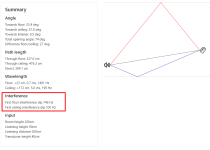
I do not see any valid reason try to bake in a dip to remedy room interaction, as the dip would be there due to room interaction anyway. Perhaps with directivity, but the speaker doesn't seem to have that kind of directivity planned in.
Is your drives same as with the pit viper? How did you measure, semi-anechoic at home with merged near field responses? Error for dip in power could be in many places, starting from measurement error to data handling error, crossover implementation error, wiring error, and so on. Check polarity of your woofers.
Unfortunately this kind of stuff is reality, mistakes happen. But fortunately they are reality meaning that they can be successfully reasoned and found out where it comes from and then acted upon, it's not black magic, just some work that needs to be done.
If the dip exists in original design, then that's it, you'd better look for something else if you don't want it there.
Every speaker should get measured after it is fully build, then crossover needs to be tailor fit to it (simulation), and confirmed (measurement) it ended up what it should be. Now you can be fairly sure any dips you measure are from room interaction. If you mix and match crossovers and physical structures that are not related, you'll get what you happen to get, non-optimized end result.
edit. hahaa, AI illustrating tailor fit
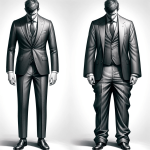

I do not see any valid reason try to bake in a dip to remedy room interaction, as the dip would be there due to room interaction anyway. Perhaps with directivity, but the speaker doesn't seem to have that kind of directivity planned in.
Is your drives same as with the pit viper? How did you measure, semi-anechoic at home with merged near field responses? Error for dip in power could be in many places, starting from measurement error to data handling error, crossover implementation error, wiring error, and so on. Check polarity of your woofers.
Unfortunately this kind of stuff is reality, mistakes happen. But fortunately they are reality meaning that they can be successfully reasoned and found out where it comes from and then acted upon, it's not black magic, just some work that needs to be done.
If the dip exists in original design, then that's it, you'd better look for something else if you don't want it there.
Every speaker should get measured after it is fully build, then crossover needs to be tailor fit to it (simulation), and confirmed (measurement) it ended up what it should be. Now you can be fairly sure any dips you measure are from room interaction. If you mix and match crossovers and physical structures that are not related, you'll get what you happen to get, non-optimized end result.
edit. hahaa, AI illustrating tailor fit

Last edited:
pit viper woofer low pass seems to use quite high component values, 5mh and 150uf cap. I'm not sure if this is normal, not that familiar with passive xo's.
Using another woofer, Kontinainen demo that comes with VituixCAD the pit viper low pass seems odd and I can see it could produce similar system response as you have:
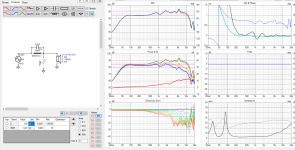
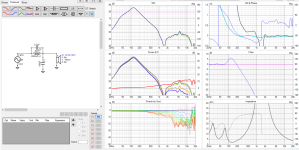
If the low pass filter components are halved, the response looks more akin to https://sites.google.com/site/undefinition/floorstanding-speakers/pit-vipers

But since it is different woofer there is no proof here 🙂 Could be your mid as well, or any other error.
Best would be to measure your box, and design xo from scratch. At least you could now pop-in the pit viper xo into simulator to see what it should measure. If it's fine you've got error somewhere. If it's bad you could just tweak it. It should help you to reason what's wrong and learn new stuff.
Using another woofer, Kontinainen demo that comes with VituixCAD the pit viper low pass seems odd and I can see it could produce similar system response as you have:


If the low pass filter components are halved, the response looks more akin to https://sites.google.com/site/undefinition/floorstanding-speakers/pit-vipers

But since it is different woofer there is no proof here 🙂 Could be your mid as well, or any other error.
Best would be to measure your box, and design xo from scratch. At least you could now pop-in the pit viper xo into simulator to see what it should measure. If it's fine you've got error somewhere. If it's bad you could just tweak it. It should help you to reason what's wrong and learn new stuff.
Last edited:
Simple illustration how trying to EQ a reflection does nothing. What one needs is as wide bandwidth attenuation toward reflection as possible. All else is just fidding around for no particularly good reason. I'm simplifying here for illustration, not taking account any auditory system properties for example.I'd prefer to get the speaker right at the xover first.
Another user has sim'd the speaker and suggest the dip is intentional, possibly to alleviate floor reflections. He posted a modified xover that appears to resolve the dip. It's a very cheap mod so I may try that and report back.
Ideal sound source, has flat response.

Mix in singular reflection delayed suitably to make huge dip around 400Hz. Strong comb filter ensues.
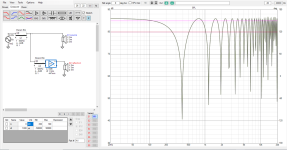
Now, what if we EQ? Nothing happens, the interference is as bad as before and now there would be issue with the speaker tonality (power response).
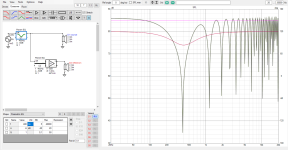
Even if just the reflection was EQ:d by arraying two woofers, MTM kind of thing. Dip is still there, not as bad but even the destructive interference was completely removed around 400Hz there is constructive interference both sides of it so in total there would still be a dip.
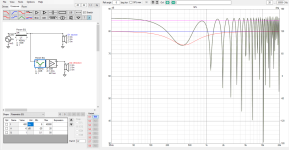
What cures this stuff is wide bandwidth attenuation towards the reflection point, not EQ or any other narrow bandwidth frequency response manipulation.
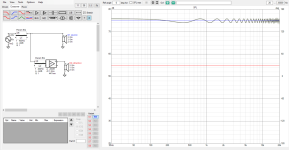
If one wants to approach performance of "ideal sound source" this stuff can be generalized to reduction / elimination of secondary sound sources, those from the speaker, and those from the room. In reality it's not possible to have ideal sound sources, so multiple sound sources on a loudspeaker, like an array, could be to reduce room interaction and so on. What ever seems most appropriate speaker system for given application taking account auditory system and room.
Last edited:
It's the same thing. Are you interested in making this large amount of EQ with the crossover?I'd prefer to get the speaker right at the xover first.
I just want the speaker to exhibit a more flat on axis response with a passive xover. I was hoping to use the parts I have and the pcb but oh well, might be easier to just make a whole new, boy this stuff can sure eat money.
Would be easy to know if the designer existed on the internet but he doesn't reply to any of my messages so I just have to figure it out myself.
I will say that dip isn't from my room, I've measured the speakers in 3 different environment and it's there in all of the measurements.
If the dip exists in original design, then that's it, you'd better look for something else if you don't want it there.
Would be easy to know if the designer existed on the internet but he doesn't reply to any of my messages so I just have to figure it out myself.
I will say that dip isn't from my room, I've measured the speakers in 3 different environment and it's there in all of the measurements.